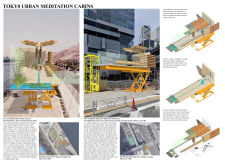5 key facts about this project
The architecture of the meditation cabins exemplifies modular design principles that promote flexibility in placement throughout various urban settings. By utilizing key materials such as granite, cypress wood, glass, and concrete, these structures showcase a thoughtful application of natural and industrial elements. The design invites users to embrace tranquility while engaging with the surrounding environment, thereby promoting a connection between human activity and nature.
Unique Structural and Material Approaches
What sets the Tokyo Urban Meditation Cabins apart from other architectural projects is the innovative use of materials that transition from raw conditions to refined finishes. This approach not only emphasizes the beauty of natural materials, such as cypress wood and granite, but also reflects the project’s intention of establishing a seamless dialogue between the built environment and the natural landscape.
The cabins feature modular configurations, which allows for adaptability in various urban contexts, such as parks and public gathering spaces. This adaptability is crucial for enhancing accessibility and ensuring that the cabins provide a retreat option in diverse locations. The integration of water features, including streams and pools, further contributes to the overall calming atmosphere, actively engaging users through visual and acoustic elements.
User Engagement and Experience Design
The design specifically addresses the flow of user movement, creating clear pathways that guide individuals from the dynamic urban environment into a space of contemplation. Each cabin is designed to provide an intimate experience while simultaneously offering panoramic views of the surrounding landscape. The design intent focuses on minimizing noise diversion from the urban atmosphere, effectively allowing users to immerse themselves in a meditative state.
The use of glass within the cabins ensures that both natural light and visibility are maximized, fostering a strong connection between indoor and outdoor spaces. This transparency encourages users to engage with their surroundings while maintaining a sense of privacy. Each of these design choices works cohesively to enhance the user experience and facilitate mindfulness practice in an urban context.
To gain deeper insights into the architectural plans, sections, and overall design concepts of the Tokyo Urban Meditation Cabins project, readers are encouraged to further explore the project's presentation. This examination will reveal additional details surrounding its architectural ideas and unique implementation strategies that address contemporary urban challenges.























